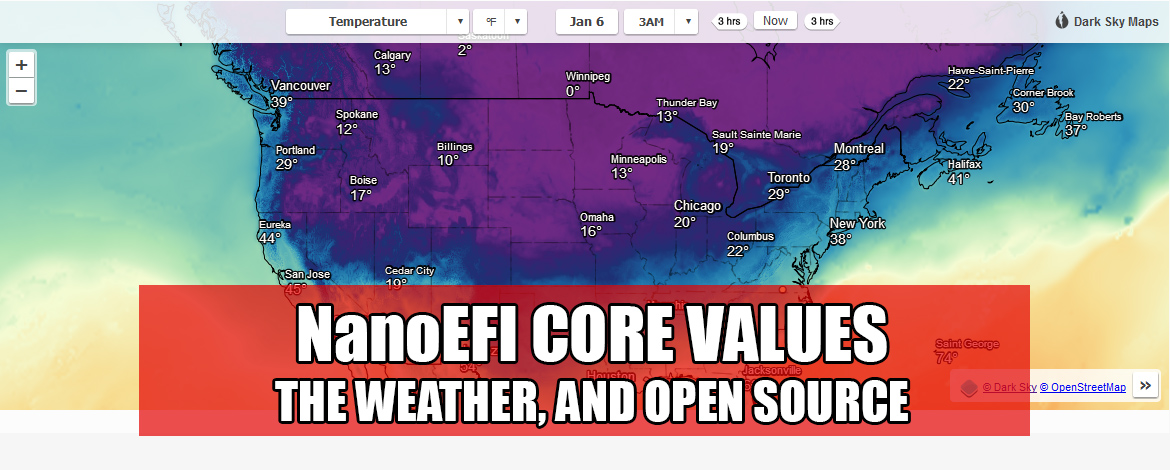Motivation behind NanoEFI
Before I’m a developer, I’m a rider and off road enthusiast first. We see very little snowfall here in Virginia, so it’s always a treat to ride these days. Unfortunately, colder weather here usually means spending an hour re-jetting and fiddling with the carburetor. As a daily rider, I’m eager to eliminate these hassles. And I’m done waiting over a decade for others to make a decently priced EFI kit available. In the end, I want to be able to just ride without spending so much time tinkering.
NanoEFI started as my way to have the EFI kit that I’ve always wanted to purchase, but was never available or just way too expensive.
Getting NanoEFI’s Values Right
With development nearing the Alpha and Beta stages soon, I’m doubling down on what I feel are the three most important aspects:
Rule #1: AFFORDABILITY
The highest priority is a super low final kit price. As of today, we continue to stay on target below a third of the nearest priced small engine EFI kit. The final price of the full NanoEFI retrofit kit is intended to compete in the price realm of mid-high end carburetors.
After all, a product is worthless if it doesn’t fit into your budget.
Rule #2: AVAILABILITY
Being a dependable supplier. Every design decision takes into account how the ease of manufacturing will be affected. The best design in the world is useless if you can’t deliver the product.
To this end, the second rule of NanoEFI is to produce a streamlined design that facilitates an “always-in-stock” policy.
Rule #3: ANYONE CAN USE IT (low technical barrier)
EFI installation will never be as easy as making a ham sandwich, but it isn’t rocket science either.
Third rule: No complex tool chains, extra expensive hardware for tuning, and no dependency on third party tuning software. From the user’s perspective, the basic experience for a product like this should be that it just works, intuitively. That’s it.
Open Source?
After a lot of consideration, I’ve come to the conclusion that going open isn’t the right path for NanoEFI in the foreseeable future. This isn’t a permanent decision, but it’s true for now. This is why:
Open Source EFI projects already exist, but I believe they miss the mark for most riders.
There are several open source EFI and EMS projects to choose from today. But I feel that they lack focus on the most important areas for widespread use:
1. Price..? 2. In stock..? 3. Easy to use..?
From the perspective of a rider, current open EFI projects are most useful to the maker and hacker crowds. For most riders, the technical barrier is too high and there isn’t enough focus on getting the price down. The experience needs to be simpler and more affordable.
To this end, I’ve made the decision to keep NanoEFI’s core closed and tightly focused on developing a purpose-driven package.
For Developers: Open API and NanoEFI Developer IDE
Do you still want to mod and customize your NanoEFI build? I feel that having a closed core, with an open extensions ecosystem and community is the best solution, and rounds out the interests of everyone.
- Cloud based NanoEFI IDE (Very excited about this)
- OTA flashing – Compile and burn your own code to the board via WiFi
- Open developer API
- Optional (currently unused) processor pins broken out on the board
The NanoEFI core is focused on powersports vehicles, but there are many applications that I’m contacted about regularly:
- Off-site remote generators
- Outboard Marine engines
- Industrial equipment
- Farming and irrigation systems
- Riding lawnmowers
- Alternative fueling
- Eco marathons and school competitions
- RC Helicopters and other types of hobby vehicles
A well documented API reference will be created for owners and developers of these machines. So you can develop your own NanoEFI extension to add sensors, modify timing routines, implement new trigger setups, etc.
The strategy to implement extensions will be covered more in-depth in a later update.
Thanks for the interest!
I’ll continue to post these articles covering the technical details of new developments and progress. I enjoy explaining how the system works, what is happening internally, and the methods behind the progress.
Like updates?
 If you’re also a rider wanting cheap and easy EFI, be sure to like, share and comment on the NanoEFI Facebook page.
If you’re also a rider wanting cheap and easy EFI, be sure to like, share and comment on the NanoEFI Facebook page.
With a bigger audience, I can prioritize communicating more often. Help get the word out, and share this project with your friends! 😀





This is great now the question we are all thinking about is when will you be able to ship them out as I am sure there are many of us just dying to buy one from you!
Truly, and the second question is where can we help?
Great work keeping this very exciting project going!
Its not just very cool to think of possible applications, but also to learn from these posts describing the design process and decisions made along the way.
My hope is to be included in the earliest possible batch, waiting patiently to hand over funds 🙂
Keep up the excellent work, and ride safely,
D
This project just lost for me. Speeduino for ever
Josh has done a great job over at Speeduino, and I fully recommend everyone interested in NanoEFI also check out (and bookmark) their project.
From my perspective, NanoEFI doesn’t directly compete with Speeduino or other existing open source options. The intended users of NanoEFI are the majority of small engine owners who want to just install the system and never touch it again. They want it cheap, and on the shelf ready for quick delivery, with minimal technical fuss. As development has progressed in recent months, it has become more clear that this is where we fit best, and what we’re going to achieve here.
NanoEFI will have strong DIY development features. So don’t write us off just yet if you’re interested in modding or developing on top of this platform.
In the end, different projects have different goals. There is enough space for everyone without needing to declare for one perceived side or another. 🙂
Sounds like you’re on the right track. Count me in as a perspective buyer.
so when will these possibly be ready id like one now if possible
Has there been any more development?
How long until i can buy one?
Just wondering what kind of hardware we need to find? Things like throttle body, injector, etc. Really looking for this to be done and wish I could help with the coding, but not a programmer. Just put a carb, cam, and higher compression piston on my little race bike, and going EFI would have been a better choice but nothing that really fits. You can see what I’m racing and what I’ve been doing to it at my site (which I’m not allowed to link)
Just noticed that if you click on my name, it will send you to my website. No, not a spammer. Just a hobby racer.
Hello, your project is exactly what I’m looking for.
Is it available?
Also waiting for this to convert my old trail bike to efi.
If I can help with any mechanical hardware that requires machine shop/CNC equipment to make, just ask.
Hi I am an embedded firmware developer as well and I have also thought about making my own EFI system.
Are you looking for additional developers?
Will this product be able to support 2 cylinders? I have an old garden tractor with an Onan 2 cylinder engine and would love to EFI it.
Just found this, I am extremely interested for several different projects. Was considering the Ecotrons unit, but this sounds far better. Following intently.
I’m looking forward to the day when I can ditch the carbs on my pair of Carter Bros.150cc GY6 karts. Just tried to take my grandchildren for a ride this AM and couldn’t get either kart to start. If this EFI can deliver more reliable engine operation, then I’m IN.
DC Ruckus rider here wondering what performance gains can be expected from your EFI on GY6 engines
Is there anything we can do to help speed the process for you?